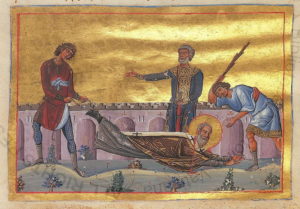Feast Day ~ June 5
 The Martyrology contains the names and stories of hundreds of thousands who gave up their lives simply for being Christians. These courageous saints lived and died all over the world – wherever the love of Christ was a threat to those in power – and every day, more and more names are being added to their ranks.
The Martyrology contains the names and stories of hundreds of thousands who gave up their lives simply for being Christians. These courageous saints lived and died all over the world – wherever the love of Christ was a threat to those in power – and every day, more and more names are being added to their ranks.
In our day, when keeping detailed records and exact identification (even to fingerprints and the pupils of our eyes) are so important, it is often frustrating to discover that clear facts about the life and witness of a martyr do not exist, or that information about one is confused with another, or that there are conflicting reports regarding a martyr. But martyrdom in itself, when endured willingly for the sake of one’s faith, is enough to merit the title “saint”. Stories of the life of St. Dorotheus of Tyre, who was martyred in the reign of the Emperor Julian (the “Apostate”), include several variations and discrepancies, but his martyrdom is never questioned.
Dorotheus was from Antioch, probably born around the year 255. He was described by the Church historian Eusebius as “enraptured with the study of divinity” and most stories of him agree that, as a young man, he had acquired a thorough education both in classical learning and in Holy Scripture. He had a gift for languages and mastered Hebrew in order to study Old Testament writings in their original language. He evidently spent some of his youth studying in Rome and was also fluent in Latin. Some reports say that it was in that imperial city that he began writing about the sayings of the Apostles, including those of the “Seventy”. Dorotheus was ordained to the priesthood in Antioch and was respected as a teacher of Holy Scripture in the church there.
Despite being a priest of a religion which was beginning to be targeted for persecution, Fr. Dorotheus was awarded the position of manager of the government-controlled dye industry in the city of Tyre, as reported by Eusebius in his History of the Church. (Dorotheus must have struggled with the dual responsibilities of his positions as do those priests of today who also engage in secular work.)
Many sources say that Dorotheus was appointed Bishop of Tyre and soon after, the persecutions of Christians became more intense. At the urging of his flock and following the admonition of our Lord as recorded in the Gospel of Matthew (“When they persecute you in this city, flee to another.” Mt. 10:23), Bishop Dorotheus hid from the officials until Constantine became the Emperor and removed the impediments to the practice of Christianity. There followed a long period of peace for the Church.
Some accounts report that Bishop Dorotheus, already 70 years old, was present at the Council of Nicea in the year 325, helping to articulate Christological issues and establish the means of determining the date of Pascha.
When Julian, who had turned away from the Christian faith of his youth and was therefore known as the “Apostate”, became Emperor in 361, a new persecution began. Once again Dorotheus went into exile, but he was hunted down by the soldiers and was savagely beaten. Never once faltering in his steadfast declaration of the truth of Christianity, St. Dorotheus, who had now attained the age of 107, died from his tortures on June 5, 362.
It is not necessary for us to be able to prove the “facts” of St. Dorotheus’ life. It does not matter if some of the details of this story have, through the centuries, been mixed with those of another’s life. What does matter is that a faithful Christian willingly gave up his life rather than deny his Lord and that Christians since his time have asked for his prayers. Holy Dorotheus, pray for us. That we, too, may be steadfast in the faith.
Resources: A Cloud of Witnesses by Bishop Demetri Khoury; Prologue From Ochrid by St. Nikolai of Ochrid; Orthodox Saints, Vol. 2, by George Poulos; The History of the Church by Eusebius; the websites of the OCA and OrthodoxWiki.